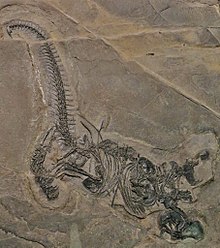Drepanosaurus
| Drepanosaurus Temporal range: Late Triassic
| |
|---|---|

| |
| Fossil | |

| |
| Sketetal diagram scale bar = 1 cm | |
| Scientific classification | |
| Domain: | Eukaryota |
| Kingdom: | Animalia |
| Phylum: | Chordata |
| Class: | Reptilia |
| Clade: | †Drepanosauromorpha |
| Family: | † Drepanosauridae
|
| Genus: | †Drepanosaurus Pinna, 1979 |
| Species: | †D. unguicaudatus
|
| Binomial name | |
| †Drepanosaurus unguicaudatus Pinna, 1979
| |
Drepanosaurus (
Description

Drepanosaurus is known to have a huge claw on the "index finger" (digit II) of each hand along with the tail claw. The skull of Drepanosaurus has never been found and is still unknown; however, the skull of Drepanosaurus was likely similar to other drepanosaurs, such as Megalancosaurus. Megalancosaurus' skull was approximately the same size as its enlarged claws, and had a bird-like jaw and head shape.[1]
The forelimb of Drepanosaurus is highly modified compared to other vertebrates. Its
The dorsal neural spine humps of Drepanosaurus are much taller along all succeeding spines reaching down to the sacrum.

Discovery and classification
Discovered in northern Italy in 1979, Drepanosaurus was named by Giovanni Pinna, a paleontologist and museologist.[5] The species name is Drepanosaurus unguicaudatus.[6] It is derived from the Greek for "sickle lizard." Only one incomplete adult specimen has been found. Another partial specimen of Drepanosaurus was found in New Mexico's Chinle Formation in 2016.
Drepanosaurus is part of the clade
Paleobiology

Drepanosaurus is hypothesized to have been an insectivore, using the claws on the second digits to lift bark and dig into crevices and grooves on trees to find insects.
It has been suggested that Drepanosaurus was also a digging animal, and could use the clawed tail as a tool for unearthing insects. However, it is not thought that Drepanosaurus's tail was flexible enough to be used for digging, especially since many characteristics point to an arboreal lifestyle.
Paleoecology

Being only 45–50 centimetres (18–20 in) in length, Drepanosaurus likely spent its time in trees using its clawed hands and feet to climb from branch to branch, as well as its prehensile tail, much like a chameleon. The claw on the tip of the tail may have also been used to grip branches.[5] Drepanosaurus is much larger than its relatives, more than double the length of Megalancosaurus. Most drepanosaurs are thought to be tree-dwelling insectivores with similar body structures to Drepanosaurus, except for minor differences usually dealing with forelimb configuration and head shape disparities.
Drepanosaurus inhabited forests in what is now
See also
References
- ^ Wedel, M. (2007). "Drepanosauromorpha, the "monkey lizards"". ucmp.berkeley.edu.
- S2CID 53339494.
- S2CID 128645833.
- ISSN 0024-4082.
- ^ a b Pinna, G. (1980). "Drepanosaurus unguicaudatus, nuovo genere e nuova specie di Lepidosauro del trias alpino". Atti della Soc Ital di Sci Nat del Mus Civ di Storia Nat di Milano. 121: 181–192.
- S2CID 83840423.
